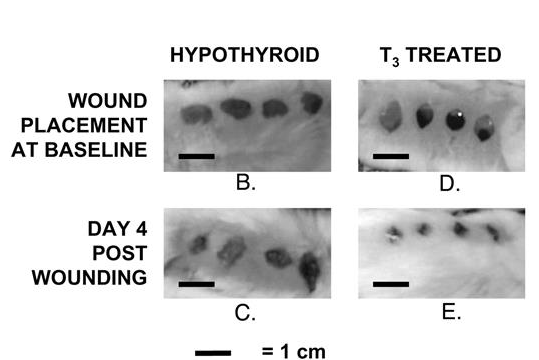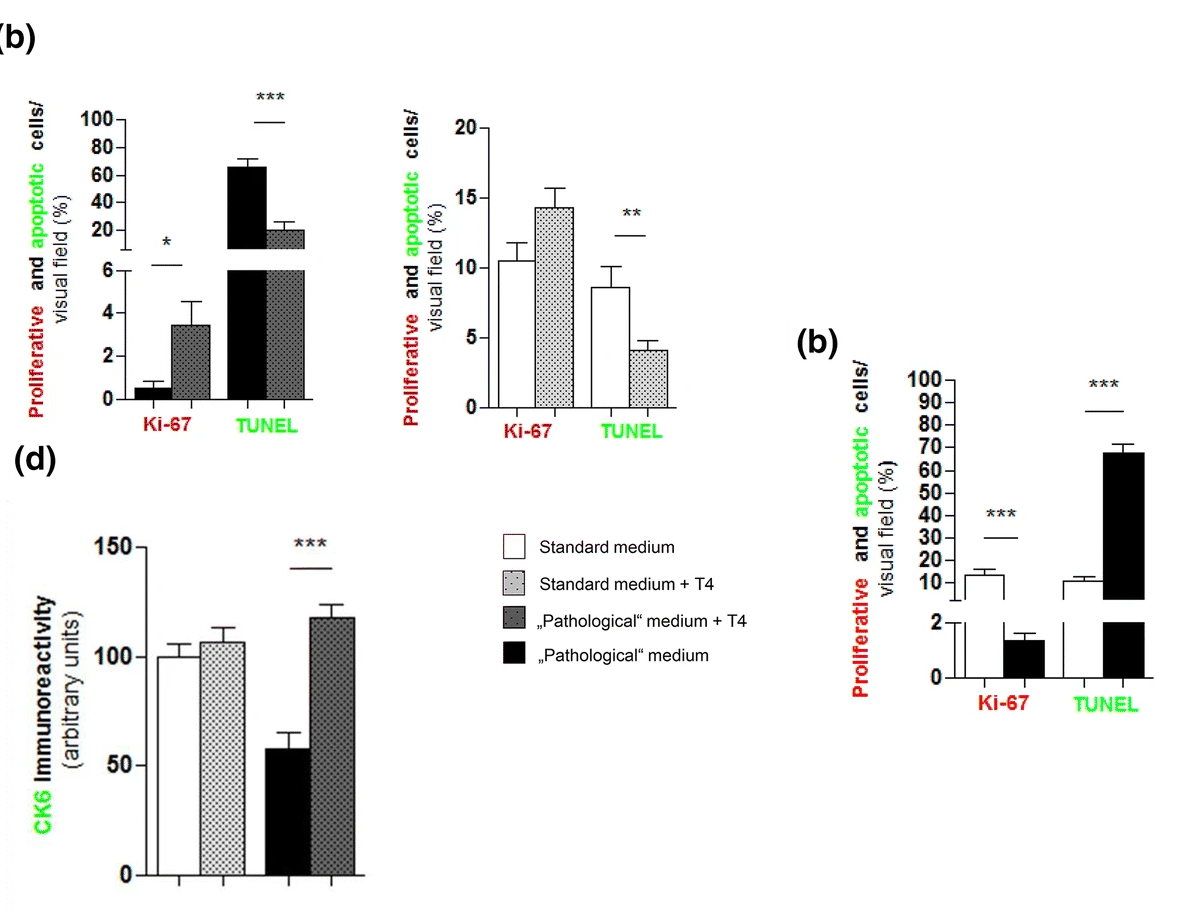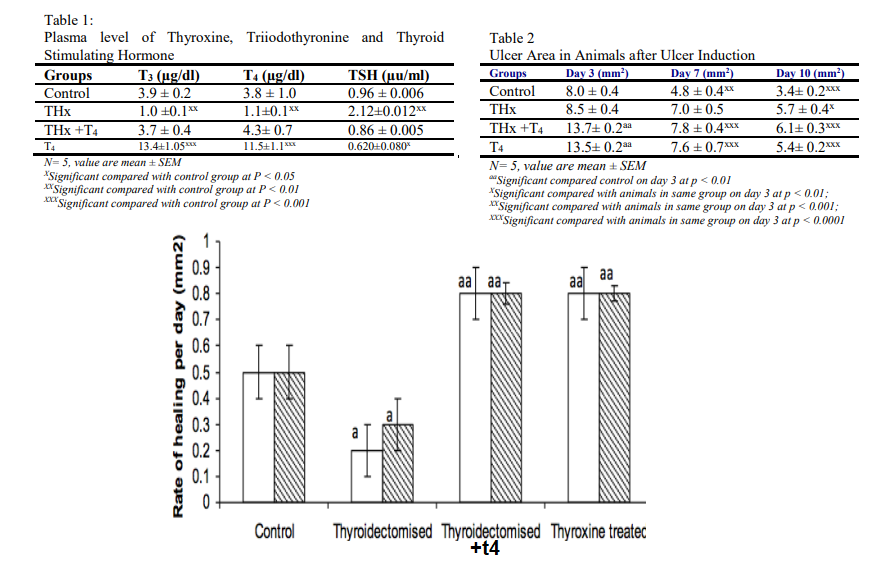Topical T3 thyroid hormone greatly accelerates wound healing 4x (and non topical vs hypothyroid) [chronic diabetic ulcer]
-
Chronic wounds, human trial, massive beneficial effect
https://pubmed.ncbi.nlm.nih.gov/37226792/16 days for complete wound closure with topical t3 applied vs 60 days for the honey cream treated group
*The mean time to complete wound closure in the routine care group was about 60.6 days, while it was 15.9 and 16.4 days in T3 and T3/Ins groups, respectivelyAt the time of study termination, all participants in each of the T3 or T3/Ins groups were free of symptoms based on the REEDA score**, while about 40% of participants in the control group were detected with each of grades 1, 2, or 3.
https://academic.oup.com/endo/article/145/5/2357/2878224?login=false
. To examine TH requirement for optimal wound healing, we contrasted TH-deficient vs. ip T3-treated mice.
Four days after wounding, ip T3-treated mice had twice the degree of wound closure as hypothyroid mice (P < 0.001).
By RT-PCR, K6a and K17 gene expression from control mouse skin was greater than from hypothyroid mouse skin: 5- (P < 0.001) and 1.7-fold (P < 0.05), respectively.T3 is necessary for the keratinocyte proliferation required for optimal wound healing. T3 exerts influence by stimulating expression of the wound-healing keratin genes. Thus, for hypothyroid patients undergoing surgery that cannot be delayed until euthyroidism is achieved, our data support T3 treatment for the perioperative period.
 59aa498a-d2ea-479f-a94f-3ab27637c6cd-image.png 1710426900812.png
59aa498a-d2ea-479f-a94f-3ab27637c6cd-image.png 1710426900812.png^ systemic effect delivered i.p so not just when used on skin directly
https://www.semanticscholar.org/paper/Topical-thyroid-hormone-accelerates-wound-healing-Safer-Crawford/1ea1674d23db91c84c88ef5ec2cd7931e3e5cff8
^ used on skin in mice, dose 150ng
Daily topical application of 150 ng T3 resulted in 58% greater wound closure relative to wounds on the same animals receiving vehicle alone& this one is interesting - showing thyroxine (T4) also works to restore wound healing and when conditions are set up for hypoxic and high oxidative stress tissue which otherwise prevented healing
link.springer.com
Thyroxine restores severely impaired cutaneous re-epithelialisation and angiogenesis in a novel preclinical assay for studying human skin wound healing under “pathological” conditions ex vivo - Archives of Dermatological Research
Impaired cutaneous wound healing remains a major healthcare challenge. The enormity of this challenge is compounded by the lack of preclinical human skin wound healing models that recapitulate selected key factors underlying impaired healing, namely hypoxia/poor tissue perfusion, oxidative...
link.springer.com link.springer.comwe sought to further mimic “pathological” wound healing conditions by culturing experimentally wounded, healthy full-thickness frontotemporal skin from three healthy female subjects for three days in either serum-free supplemented Williams’ E medium or in unsupplemented medium under “pathological” conditions (i.e. hypoxia [5% O2], oxidative damage [10 mM H2O2], absence of insulin, excess glucose)
Indeed, thyroxine administration sufficed to rescue re-epithelialisation (p < 0.001) and promoted both epidermal keratinocyte proliferation (p < 0.01) and angiogenesis in terms of CD31 immunoreactivity and CD31 positive cells under “pathological” conditions (p < 0.001) ex vivo.
(and also boosted in standard tissue environment)

-
Another good read
Thyroid hormone action on skin
From the article
Topical thyroid hormone may serve as a useful means to accelerate wound healing rate. Topical application of supra-physiological doses of T3 accelerated wound healing in normal mice40 and a human wound healing formulation has been described that requires T4 in addition to growth hormone and insulin.41
The importance of thyroid hormone in wound healing had been debated. In 1973 and 1974, Mehregan and Zamick reported that oral T3 accelerated the rate of wound healing in euthyroid rats and improved the quality of the wounds.42,43 In addition, scars were smoother in the T3 treated animals. Lennox and Johnston reported accelerated wound healing and increased tensile strength when rats were given supra-physiologic doses of T4.44 Although Pirk et al. reported no change in wound healing with 1.3 µg/100 mg body weight intraperitoneal T4 in hamsters, the investigators noted increased rate of fracture repair.45 Ashton et al. also reported increased fracture repair rate in mice given 20 µg/100 mg body weight subcutaneous T4.46 There are also reports of hypothyroid patients who required thyroid hormone to achieve healing of radiation induced neck fistulae.49,50 Conversely, Cannon49 reported that hypothyroidism did not diminish wound strength in pigs and Ladenson et al.50 did not detect wound healing deficits in hypothyroid humans.
-
This post is deleted! -
@Martiño It looks like you posted in the wrong thread
-
Thanks for the reads, good stuff here. The ability to accelerate wound healing under "pathological" conditions, especially diabetic foot ulcers, is very significant. I am unable to read the full study, I would like to see the numbers.
I am curious whether severe ulcers and deep wounds(in general) can be accelerated. Pressure sores and MRSA infections would also be of interest to me. If the thyroid application is accelerating healing, then I assume that there's immune-protective effects. I'd like to see a test of topical thyroid and its effect on MRSA recovery and wound healing.
-
@Peatly oh jajaja yeah, i will delete now.
-
@JulofEnoch said in Topical T3 thyroid hormone greatly accelerates wound healing 4x (and non topical vs hypothyroid) [chronic diabetic ulcer]:
@cs3000
I am curious whether severe ulcers and deep wounds(in general) can be accelerated. Pressure sores and MRSA infections would also be of interest to me. If the thyroid application is accelerating healing, then I assume that there's immune-protective effects. I'd like to see a test of topical thyroid and its effect on MRSA recovery and wound healing.should apply all over for a general effect, 1 of the studies showed taking i.p so not applied at wound site , also increased the chronic wound healing.
& id imagine would apply to severe ones should be the same mechanism needed to repair rightand this one "Thyroxine Accelerates Healing of Acetic Acid-Induced Gastric Ulcer" for some reason the t4 groups had bigger initial ulcers measured at day 3. but the t4 groups had faster healing, vs hypothyroid and vs controls. and using t4 which is less efficient than t3

But there can probably be a problem in illness taken orally vs topically , t3 would have to actually bind nuclear receptor for effect probably & if t3 is shut down by deiodianse 3 enzyme being upregulated in illness might not get the effect. where on skin its easier to overwhelm the enzyme with high dose locally for local effect (high dose as in would be a high dose for the cells taking it in vs what they get systemically)